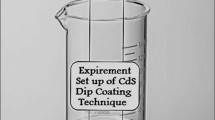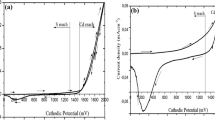Abstract
Cadmium sulphide (CdS) thin films have been successfully prepared from an aqueous electrolyte bath containing CdCl2 and ammonium thiosulphate ((NH4)2S2O3) using electrodeposition technique. The structural, compositional, optical, morphological and electrical properties of these thin films have been characterized using X-ray diffraction (XRD), Raman spectroscopy, energy dispersive X-ray spectroscopy, UV–Vis spectrophotometry, scanning electron microscopy (SEM), atomic force microscopy (AFM), photoelectrochemical cell and D.C. current–voltage (I–V) measurements. The optimum deposition cathodic potential has been observed at 1,455 mV, in a 2-electrode system with respect to carbon anode. Structural analysis using XRD shows a mixture of hexagonal and cubic phases in the as-deposited CdS samples and a phase transformation to the hexagonal structure occurred after heat treatment at 400 °C for 20 min. Optical studies demonstrate an improvement in the band edge, producing 2.42 eV for the band gap of the films after heat treatment. The heat treated CdS thin films show better transmission for wavelengths longer than 500 nm. SEM and AFM show that the heat-treated samples are more uniform, smoother and have larger grain size. Electrical studies confirm that the CdS thin films have n-type electrical conductivity and heat treated CdS thin films have resistivities of the order of 105 Ω cm.















Similar content being viewed by others
References
D. Lincot, M. Fromen, H. Catchet, Advance in Electrochemical Science and Engineering, vol. 6 (Wiley, New York, 2008), p. 118
S.K. Das, G.C. Morris, Sol. Energy Mater. Sol. Cells 28, 305 (1993)
R.K. Sharma, K. Jain, A.C. Rastogi, Curr. Appl. Phys. 3, 199 (2003)
A. Ziabari, F.E. Ghodsi, Sol. Energy Mater. Sol. Cells 105, 249 (2012)
H. Metin, R. Esen, J. Cryst. Growth 258, 141 (2003)
A. Hasnat, J. Podder, J. Sci. Res. 4(1), 11 (2012)
K. Yamaguchi, T. Yoshida, T. Sugiura, H. Minoura, J. Phys. Chem. B 102, 9677 (1998)
D.G. Diso, G.E.A. Muftah, V. Patel, I.M. Dharmadasa, J. Electrochem. Soc. 157(6), 647 (2010)
M.N. Mammadov, A.S. Aliyev, M. Elrouby, Int. J. Thin Film Sci. Technol. 53(2), 43 (2012)
P.C. Hayes, S.H. Algie, Process Principles in Minerals and Materials Production, (1993) http://courses.chem.indiana.edu/c360/documents/redpot.pdf. Accessed 21 May 2014
I. Kaur, D.K. Pandya, K.L. Chopra, J. Electrochem. Soc. 127(4), 943 (1980)
G. Mustafa, M.R.I. Chowdhury, D.K. Saha, S. Hussain, O. Islam, Dhaka Univ. J. Sci. 60(2), 283 (2012)
M. Ichimura, F. Goto, E. Arai, J. Appl. Phys. 85(10), 7411 (1999)
F.C. Campbell, Phase Diagram: Understanding the Basics, 1st edn. (ASM International, USA, 2012), pp. 73–81
M. Schulz, W. von der Osten, U. Rossler, O. Madelung, Landolt-Bornstein: Numerical Data and Functional Relationships in Science and Technology, 1st edn. (Springer, New York, 1987), pp. 33–56
T.L. Chu, S.S. Chu, C. Ferekides, C.Q. Wu, J. Britt, C. Wang, J. Appl. Phys. 70, 7608 (1991)
K. Kitahara, T. Ishii, J. Suzuki, T. Bessyo, N. Watanabe, Int. J. Spectrosc. (2011). doi:10.1155/2011/632139
H. Oumous, H. Hadiri, Thin Solid Films 386(1), 87 (2001)
S. Preusser, M. Cocivera, Sol. Energy Mater. 20(1), 1 (1990)
L. Tian, R. Dieckmann, J. Non-Cryst. Solids 281(1–3), 55 (2001)
M.M. Smedskjaer, Q. Zheng, J.C. Mouro, M. Potuzak, S. Morup, Y. Yue, J. Non-Cryst. Solids 357(22–23), 3744 (2011)
A. Osaka, S. Takao, K. Oda, J. Takada, Y. Miura, Memoirs of the Faculty of Engineering, Okayama University 24(1), 54 (1989)
J. Hiie, T. Dedova, V. Valdna, K. Muska, Thin Solid Films 443, 511 (2006)
Acknowledgments
The authors would like to thank P. Bingham, F. Fauzi, H. I. Salim, M. Madugu, O. Olusola and A. Ojo for their valuable contributions. The members at Institute of Organic Catalysis and Electrochemistry, Kazakhstan are acknowledged for their contributions on AFM characterization in this research. The main author would also like to acknowledge the Ministry of Higher Education Malaysia and National Defence University of Malaysia for financial support.
Author information
Authors and Affiliations
Corresponding author
Rights and permissions
About this article
Cite this article
Abdul-Manaf, N.A., Weerasinghe, A.R., Echendu, O.K. et al. Electro-plating and characterisation of cadmium sulphide thin films using ammonium thiosulphate as the sulphur source. J Mater Sci: Mater Electron 26, 2418–2429 (2015). https://doi.org/10.1007/s10854-015-2700-5
Received:
Accepted:
Published:
Issue Date:
DOI: https://doi.org/10.1007/s10854-015-2700-5




